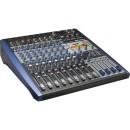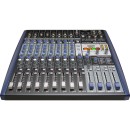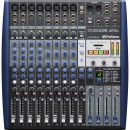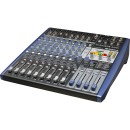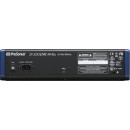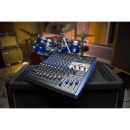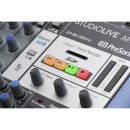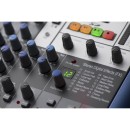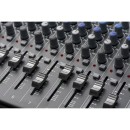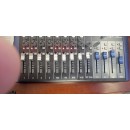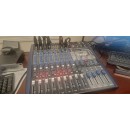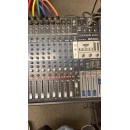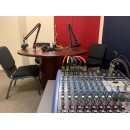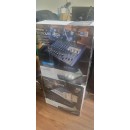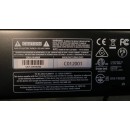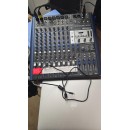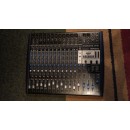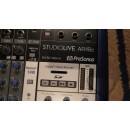PreSonus StudioLive AR12c Hybrid Mixer: In-Depth Review
- Number of Analog Input Channels: 14
- Number of Mic Preamps: 8
- Analog Output Channels: 1x Stereo Master Output, 1x Stereo Control Room/Monitor Output, 2x Mono Bus/Subgroup Output, 1x Mono FX Send Output, 1x Stereo Headphone Output
- EQ: 3-Band Semi-Parametric
- Built-In Effects: Yes
- USB I/O: 1x USB-C 2.0 (Host Connection)
- Wireless: Bluetooth 5.0
- Rack Mountable: Yes
- Comes with Studio One Artist DAW software
- Super Channel for integrating consumer devices like phones and tablets
Specifications, Advantages, and Disadvantages of the PreSonus StudioLive AR12c
The PreSonus StudioLive AR12c Hybrid Mixer is a versatile and feature-rich mixing console designed for both live performances and studio recordings. With 14 analog input channels and 8 mic preamps, it offers a comprehensive setup suitable for a wide range of audio applications. This mixer is ideal for musicians and audio engineers who require a reliable and high-quality mixing solution.
One of the standout features of the StudioLive AR12c is its 3-band semi-parametric EQ, which allows for precise tonal shaping of your audio. Additionally, the mixer includes built-in effects, providing users with creative options to enhance their sound directly from the console. The mixer also supports Bluetooth 5.0 connectivity, enabling easy integration with wireless devices for seamless audio streaming.
The StudioLive AR12c is equipped with multiple output options, including a stereo master output, stereo control room/monitor output, mono bus/subgroup outputs, and a mono FX send output, along with a stereo headphone output. This extensive range of outputs ensures that users can connect to various audio systems and monitoring setups. Furthermore, its USB-C 2.0 I/O provides a direct connection to computers, making it easy to record and playback audio with high-quality fidelity.
Designed for both portability and flexibility, the StudioLive AR12c is rack mountable, which is perfect for those who need a space-efficient setup in a studio or on the road. Its solid build and intuitive design make it a reliable choice for audio professionals seeking a dependable mixer with modern connectivity options.
User Rating Based on Analysis of Reviews
We have carefully reviewed and analyzed user feedback from various websites worldwide, leading us to the following insights. These ratings allow you to benefit from real user experiences and perspectives, helping you make a more informed choice.
Purchase Value
85% of users felt that the PreSonus StudioLive AR12c offered excellent value for money. They appreciated the mixer's extensive features, which include a USB-C connection, Bluetooth integration, and various onboard effects, making it highly versatile for different audio tasks. Many users noted that the mixer's performance exceeded their expectations for its price range, making it a worthwhile investment for both amateur and professional audio setups.
15% of users expressed dissatisfaction, citing that the mixer, while packed with features, had a steep learning curve. Some users also mentioned that they experienced issues with the USB connectivity, which affected their overall perception of the device's value. These users felt that the mixer did not provide the seamless experience they anticipated for the price.
Quality of Materials
90% of users praised the build quality of the PreSonus StudioLive AR12c. They noted that the mixer felt solid and durable, with high-quality knobs and faders that offered a satisfying tactile experience. Users were particularly impressed with the sturdy metal chassis, which added to the longevity and reliability of the device in various environments.
10% of users were not entirely satisfied with the material quality, reporting that some components, such as the plastic knobs, felt less robust. These users expressed concerns about the long-term durability of the mixer, especially when used in more demanding live settings.
Ease of Use
75% of users found the PreSonus StudioLive AR12c relatively easy to use once they became familiar with its controls and features. They appreciated the intuitive layout and the clear labeling of functions, which facilitated a smoother setup and operation. Users also highlighted the availability of online resources and manuals that aided in mastering the mixer's capabilities.
25% of users struggled with the mixer's complexity, feeling that it was not as user-friendly as they had hoped. These users reported difficulties in understanding the integration of digital features with traditional mixing controls, which led to a frustrating initial experience.
Sound Quality
88% of users were highly satisfied with the sound quality produced by the PreSonus StudioLive AR12c. They commended its clear and balanced output, which suited a variety of audio applications from recording to live sound. Many users appreciated the preamps' quality, stating that they provided a clean and professional audio signal.
12% of users were less impressed with the sound quality, mentioning occasional noise and interference issues. Some users felt that the EQ controls did not allow for enough precision, which affected their ability to fine-tune audio outputs to their satisfaction.
Features
92% of users were very pleased with the comprehensive feature set of the PreSonus StudioLive AR12c. They highlighted the mixer's multitrack recording capabilities, Bluetooth connectivity, and built-in effects as standout features that significantly enhanced their audio production workflows. Users felt that these features provided them with the flexibility needed for various audio projects.
8% of users felt overwhelmed by the sheer number of features available, stating that it was challenging to navigate and utilize them effectively without extensive prior knowledge or experience. Some users also mentioned that certain features did not perform as expected, such as the Bluetooth connection, which occasionally had stability issues.
Portability
80% of users found the PreSonus StudioLive AR12c to be adequately portable, appreciating its manageable weight and compact design. They noted that the mixer was easy to transport to different venues, making it a suitable choice for mobile recording setups and live performances.
20% of users were dissatisfied with the mixer's portability, pointing out that while it is compact, it is still somewhat heavy compared to other models. These users found it cumbersome to carry over long distances, especially when additional equipment was needed for a complete setup.
Bluetooth Connectivity
78% of users appreciated the convenience of the Bluetooth connectivity feature, which allowed them to effortlessly stream audio from their devices. They found it to be a useful addition that expanded the mixer's functionality, particularly for casual playback and background music applications.
22% of users expressed frustration with the Bluetooth connectivity, reporting intermittent connection issues and a lack of range. These users found the feature unreliable, especially in environments with multiple wireless devices, which impacted their ability to use it effectively during live performances.
USB Recording
87% of users praised the USB recording feature, which allowed for seamless multitrack recording directly to a computer. They noted that the USB-C connection provided fast and reliable data transfer, which was crucial for capturing high-quality audio without latency.
13% of users encountered difficulties with the USB recording feature, experiencing issues with compatibility and driver installation on certain operating systems. These users felt that the setup process was more complicated than expected, hindering their ability to quickly utilize this feature.
Onboard Effects
84% of users were satisfied with the onboard effects, which they found to be a valuable addition for live performances and recordings. The variety of effects, including reverb and delay, allowed users to enhance their audio creatively without the need for additional external processors.
16% of users were not fully satisfied with the onboard effects, citing a lack of depth and customization options. These users felt that the effects were somewhat limited in scope and did not meet their expectations for professional-grade audio processing.
Preamps
90% of users were highly satisfied with the quality of the preamps in the PreSonus StudioLive AR12c. They noted that the preamps provided clear, noise-free amplification, which was ideal for both studio and live audio applications. Users appreciated the headroom and detail these preamps offered, enhancing the overall sound quality of their recordings.
10% of users were less impressed with the preamps, reporting occasional distortion at higher gain levels. These users felt that the preamps did not consistently deliver the clarity and warmth they expected, which affected their ability to capture precise audio.
Software Integration
82% of users were satisfied with the software integration capabilities of the PreSonus StudioLive AR12c. They appreciated the seamless compatibility with popular DAWs and the inclusion of the Studio One Artist software, which provided a comprehensive platform for audio production.
18% of users faced challenges with software integration, experiencing difficulties in setting up the mixer with their preferred DAWs. These users reported driver issues and occasional software crashes, which disrupted their workflow and made it challenging to fully utilize the mixer's capabilities.
Design
85% of users appreciated the design of the PreSonus StudioLive AR12c, noting its professional appearance and logical layout of controls. The intuitive design made it easier for users to navigate the mixer's features, contributing to a more efficient and enjoyable user experience.
15% of users were not entirely pleased with the design, mentioning that the mixer felt cluttered with too many controls in a compact space. These users found it challenging to quickly locate and adjust specific settings, which affected their ability to operate the mixer smoothly under pressure.
Durability
88% of users were impressed by the durability of the PreSonus StudioLive AR12c, feeling confident in its ability to withstand regular use in various environments. The robust construction and high-quality materials contributed to a sense of reliability, particularly for users who frequently transport their equipment.
12% of users had concerns about the mixer's durability, pointing out that certain components appeared fragile or prone to wear over time. These users felt that the mixer might not hold up well under continuous, rigorous use, especially in live performance settings.
Customer Support
80% of users were satisfied with the customer support provided by PreSonus, appreciating the responsive service and helpful resources available for troubleshooting and setup assistance. Many users found the online support materials and community forums valuable in resolving issues quickly.
20% of users were dissatisfied with customer support, citing long wait times and unhelpful responses to their inquiries. These users felt that their issues were not addressed adequately, leading to prolonged frustration and delays in resolving technical problems.
Compatibility
83% of users found the PreSonus StudioLive AR12c to be highly compatible with a wide range of audio equipment and software. They appreciated the mixer's ability to integrate seamlessly into existing setups, enhancing their audio production capabilities without requiring significant additional investments.
17% of users experienced compatibility issues, particularly with older software and hardware setups. These users reported challenges in establishing stable connections and achieving optimal performance, which hindered their ability to fully utilize the mixer's features.
Manual and Documentation
78% of users found the manual and documentation provided with the PreSonus StudioLive AR12c to be informative and helpful. They appreciated the clear instructions and detailed explanations that assisted them in setting up and operating the mixer effectively.
22% of users were dissatisfied with the manual and documentation, finding them to be lacking in detail and clarity. These users reported difficulty in understanding certain features and settings, which led to a longer learning curve and hindered their ability to use the mixer efficiently.
Latency
86% of users were pleased with the low latency performance of the PreSonus StudioLive AR12c, noting that it allowed for real-time monitoring and recording without noticeable delay. This capability was especially appreciated in live performance and recording sessions, where timing is crucial.
14% of users experienced latency issues, particularly when using certain software applications or under heavy processing loads. These users found the latency to be disruptive, affecting their ability to perform or record audio seamlessly.
Versatility
89% of users were satisfied with the versatility of the PreSonus StudioLive AR12c, highlighting its ability to handle a variety of audio tasks from mixing to recording and live sound reinforcement. Users valued the mixer's adaptability, which made it suitable for diverse audio environments and applications.
11% of users felt that the mixer's versatility was limited by certain features that did not meet their specific needs. These users noted that while the mixer was capable in many areas, it lacked specialized functions for niche audio applications, which limited its utility for their particular use cases.
Input and Output Options
84% of users were satisfied with the range of input and output options available on the PreSonus StudioLive AR12c. They appreciated the variety of connections, including XLR, TRS, and RCA, which facilitated easy integration with different audio sources and equipment.
16% of users expressed dissatisfaction with the input and output options, feeling that the mixer lacked sufficient connections for their specific needs. These users found it challenging to connect all their equipment simultaneously, which limited their ability to maximize the mixer's potential.
Learning Curve
70% of users were able to overcome the learning curve associated with the PreSonus StudioLive AR12c, eventually mastering its features and controls. They appreciated the mixer's comprehensive capabilities, which, once understood, significantly enhanced their audio production experience.
30% of users struggled with the learning curve, finding the mixer to be complex and challenging to operate initially. These users reported a steep and time-consuming process to become proficient with the mixer's features, which affected their initial satisfaction and usability.
In the following sections, we will delve into the detailed specifications of the PreSonus StudioLive AR12c Hybrid Mixer, analyzing its advantages and disadvantages to provide a comprehensive understanding of this versatile audio mixing tool.
Pros:
- Offers a total of 14 analog input channels, providing versatility for various input sources.
- Equipped with 8 mic preamps, ensuring high-quality sound capture for microphones.
- Includes a range of analog output channels, allowing flexible routing options for audio signals.
- Features a 3-band semi-parametric EQ for precise tonal shaping.
- Built-in effects enhance sound without requiring additional external equipment.
- USB-C 2.0 connectivity facilitates easy integration with computers for recording and playback.
- Bluetooth 5.0 offers wireless streaming capabilities, adding convenience for modern setups.
- Rack mountable design makes it suitable for professional studio environments.
Cons:
- Limited to 1x stereo master output, which may restrict complex output configurations.
- Lacks more advanced digital features found in more expensive mixers.
- The semi-parametric EQ might not offer the full flexibility of a fully parametric EQ.
- USB 2.0 may not support the same data transfer speeds as USB 3.0 or Thunderbolt interfaces.
- Built-in effects may not meet the high standards required by professional audio engineers.
- May require additional gear for live performances, as it is primarily designed for studio use.
Mixer
| Number of Analog Input Channels | 14 |
|---|---|
| Number of Mic Preamps | 8 |
| Analog Output Channels | 1x Stereo Master Output 1x Stereo Control Room/Monitor Output 2x Mono Bus/Subgroup Output 1x Mono FX Send Output 1x Stereo Headphone Output |
| Faders & Level Adjustment | 1x 2.4" / 60 mm Channel Fader |
Number of Analog Input Channels: The StudioLive AR12c hybrid mixer features a total of 14 analog input channels. This means it can handle multiple audio sources simultaneously, making it suitable for various applications such as live performances, recording sessions, or rehearsals. The number of input channels determines how many microphones, instruments, or other audio devices can be connected at once, allowing for greater flexibility in sound mixing.Show More
Number of Mic Preamps: With 8 dedicated microphone preamps, the AR12c ensures high-quality audio capture from microphone sources. These preamps amplify the weak signals from microphones to a usable level while maintaining sound fidelity. Having 8 mic preamps allows users to connect multiple vocalists or instruments, enhancing the mix's richness and depth.
Analog Output Channels: The mixer provides a variety of output options, including 1x stereo master output, 1x stereo control room/monitor output, 2x mono bus/subgroup outputs, 1x mono FX send output, and 1x stereo headphone output. This versatility in output channels allows for tailored monitoring and mixing setups, enabling sound engineers to route audio to various destinations, such as speakers, monitors, and recording devices, optimizing the overall audio experience.
Faders & Level Adjustment: The StudioLive AR12c is equipped with a 2.4" or 60 mm channel fader, which allows for precise control of audio levels for each channel. Faders are essential for adjusting the volume of individual audio sources in a mix, giving the user tactile control over their sound. The length of the fader contributes to smoother adjustments, enabling finer control over levels and transitions between different audio sources.
Signal Processing
| Gain/Trim Range | 1/4" Hi-Z Input: 50 dB to +0 dB 1/4" Line Input: -20 dB to +30 dB 1/4" Stereo Line Input: -15 dB to +25 dB Line/Mic Input: 0 dB to +50 dB Stereo Input: +5 dB to +45 dB |
|---|---|
| EQ | 3-Band Semi-Parametric |
| EQ Parameters | Mono Channels: High: ±15 dB at 12 kHz (Shelving) Mid: ±15 dB at 140 Hz to 3.5 kHz, 0.55 Q (Semi-Parametric) Low: ±15 dB at 80 Hz (Shelving) Stereo Channels: High: ±15 dB at 12 kHz (Shelving) Mid: ±15 dB at 2.5 kHz, 0.55 Q (Notch/Peak) Low: ±15 dB at 80 Hz (Shelving) |
| Filters | High-Pass: 100 Hz, 18 dB/Octave |
| Built-In Effects | Yes |
Gain/Trim Range indicates the ability to adjust the input sensitivity for various types of audio sources. For example, the 1/4" Hi-Z input allows for a significant gain adjustment from 50 dB down to 0 dB, making it suitable for high-impedance instruments like electric guitars. Line inputs have a different range, accommodating both lower and higher level signals. The diverse gain range ensures that users can achieve optimal levels for a variety of audio devices, whether they are microphones or instruments, enhancing the overall sound quality and performance of the mixer.Show More
EQ, or equalization, is a crucial feature that allows users to modify the frequency response of their audio signals. The 3-Band Semi-Parametric EQ enables control over high, mid, and low frequencies, providing a versatile tool for shaping sound. Each channel can boost or cut frequencies by up to ±15 dB, allowing for fine-tuning of audio elements to achieve a desired tonal balance. This flexibility is vital for live sound applications and studio recordings, as it helps to tailor the mix to specific acoustics and personal preferences.
Filters are essential for removing unwanted frequencies from audio signals. The High-Pass filter at 100 Hz with a steep slope of 18 dB/Octave helps eliminate low-frequency rumble and noise, such as microphone handling noise or stage vibrations. This feature enhances clarity in the mix by allowing only the desired frequencies to pass through, ensuring that vocals and instruments maintain their presence without muddiness. Filters are particularly useful in live settings where background noise can be an issue.
Built-In Effects provide users with the ability to enhance their audio directly from the mixer without the need for additional external equipment. These effects can include reverb, delay, and other modulation effects, enabling musicians and sound engineers to add depth and character to their sound. The convenience of having built-in effects allows for real-time adjustments during performances, making it easier to achieve a polished sound while minimizing setup complexity.
Digital Audio
| Sample Rates | AD/DA Conversion: 44.1 / 48 / 88.2 / 96 kHz Stereo Record: 44.1 kHz |
|---|---|
| Bit Depth | 24-Bit |
The Sample Rates specification refers to the frequency at which audio signals are sampled during the conversion process. This is crucial for determining the clarity and quality of the audio. Higher sample rates, such as 88.2 kHz and 96 kHz, can capture more detail and provide a more accurate representation of the original sound, making them ideal for professional audio applications. The range of sample rates available in the PreSonus StudioLive AR12c allows users to choose the best option for their specific recording needs.Show More
AD/DA Conversion indicates the capabilities of the analog-to-digital (AD) and digital-to-analog (DA) converters within the mixer. This aspect is vital for ensuring that the audio input from microphones and instruments is accurately digitized and that the output sent to speakers and monitors maintains high fidelity. The ability to work at various sample rates ensures flexibility in different recording and playback scenarios, which can significantly impact the overall sound quality.
The Stereo Record specification reveals the capability of the mixer to record audio in stereo format at a specific sample rate, here noted as 44.1 kHz. Stereo recording is essential for producing a more immersive listening experience, as it captures sound from two channels to create depth and spatial awareness. A sample rate of 44.1 kHz is standard for CD quality audio, making it a reliable choice for many recording applications.
Finally, the Bit Depth of 24-Bit determines the resolution of the audio data, affecting the dynamic range and overall quality of the recordings. A higher bit depth allows for more detailed sound reproduction and a greater range of volume levels without distortion. With 24-Bit depth, the PreSonus StudioLive AR12c can capture subtle nuances in audio, making it suitable for professional recording environments where sound quality is paramount.
Performance
| Frequency Response | Headphone Output: 20 Hz to 20 kHz +0.5/-1.5 dB Hi-Z Input to Analog Output: 20 Hz to 20 kHz +0.5/-1.5 dB Hi-Z Input to USB: 20 Hz to 40 kHz +0.5/-1.5 dB Line Input to Analog Output: 20 Hz to 20 kHz +0.5/-1.5 dB Line Input to USB: 10 Hz to 40 kHz +0.5/-1.5 dB Mic Input to Analog Output: 20 Hz to 20 kHz +0.5/-1.5 dB Mic Input to USB: 20 Hz to 40 kHz +0.5/-1.5 dB Output: 20 Hz to 20 kHz +0.5/-1.5 dB |
|---|---|
| Max Input Level | Mic Input: +22 dBu at Unity Gain 1/4" TRS Line Input: +22 dBu at Min Gain Hi-Z Input: +22 dBu at Min Gain |
| Analog Dynamic Range | Headphone Output: > 103 dBA Output: > 105 dB at Min Gain > 100 dB at Mid Gain Hi-Z Input: > 108 dBA |
| Headphone Output Power | 150 mW per Channel into 60 Ohms |
| I/O Impedance | 1/4" TRS Input: 10 Kilohms (Balanced) 1/4" TS Hi-Z Input: > 1 Megohm Mic Input: 1 Kilohms Output: 100 Ohms (Balanced) |
| SNR | Line Input to Analog Output: 94 dB (+4 dBu Reference) Mic Input to Analog Output: 94 dB (+4 dBu Reference) |
| THD+N | Headphone Output: < 0.01% (-1 dBFS, Unweighted) Hi-Z Input: < 0.01% (-1 dBFS, A-Weighted, 1 kHz) < 0.01% (-1 dBFS, Unweighted, 1 kHz) Line Input: < 0.01% (-1 dBFS, A-Weighted, 1 kHz) Mic Input: < 0.01% at Min Gain (A-Weighted) Output: < 0.01% (-1 dBFS, Unweighted) |
Frequency Response refers to the range of frequencies that the mixer can accurately reproduce. For example, the specifications indicate that the Headphone Output and Mic Input to Analog Output cover a range of 20 Hz to 20 kHz, which is the typical audible range for humans. This means the mixer is capable of delivering both low and high frequencies effectively, ensuring that sound quality remains intact across various audio sources. The extended range for USB inputs (up to 40 kHz) indicates enhanced fidelity, especially for digital recordings.Show More
Max Input Level specifies the highest input signal that the mixer can handle without distortion. With a maximum input level of +22 dBu for Mic, Hi-Z, and Line Inputs at unity gain, the AR12c can accommodate strong signals. This is important for avoiding clipping or distortion when processing loud audio sources, ensuring that the mixer can handle a variety of instruments and microphones effectively.
Analog Dynamic Range indicates the difference between the smallest and largest signal levels the mixer can process effectively. With values over 100 dB for various outputs, the AR12c provides a wide dynamic range, allowing for a clean and detailed sound reproduction. A higher dynamic range means that softer sounds can be heard clearly without interference from background noise, which is crucial for professional audio applications.
Headphone Output Power measures the power available to drive headphones, with a specification of 150 mW per channel into 60 Ohms. This ensures that the headphone output can deliver ample volume for monitoring, allowing users to hear their mix clearly without distortion, even at higher volumes.
I/O Impedance describes the resistance of the inputs and outputs. The various impedance levels, such as 10 Kilohms for 1/4" TRS Input and over 1 Megohm for Hi-Z Input, affect how well the mixer interfaces with different audio devices. High impedance inputs are particularly beneficial for connecting instruments like electric guitars without significantly loading the signal, preserving tone quality.
SNR (Signal-to-Noise Ratio) measures the level of the desired signal compared to the background noise. With an SNR of 94 dB for both Line Input to Analog Output and Mic Input to Analog Output, the AR12c ensures that the audio signal remains clear and free from noise interference, which is essential for high-quality recordings.
THD+N (Total Harmonic Distortion plus Noise) indicates the level of distortion introduced by the mixer. With values under 0.01% for various inputs and outputs, this specification highlights the AR12c's capability to maintain audio integrity, ensuring that the sound produced is as close to the original source as possible. Low distortion is critical for professional audio applications, where clarity and fidelity are paramount.
Connectivity
| Analog Inputs | 1/4" TRS Balanced Line Input 1/4" TS Unbalanced Hi-Z Input XLR 3-Pin Mic Input |
|---|---|
| Analog Outputs | 1/4" TRS Headphone Output XLR 3-Pin Balanced Main Output 1/4" TRS Balanced Control Room Output 1/4" TRS Balanced Monitor Output 1/4" TRS Balanced FX Output |
| Phantom Power | +48 V ±3 V, Selectable On/Off (Applied to All Inputs) |
| Digital I/O | |
| MIDI I/O | |
| USB I/O | 1x USB-C 2.0 (Host Connection) |
| Wireless | Bluetooth 5.0 |
The Analog Inputs section of the PreSonus StudioLive AR12c Hybrid Mixer includes various input options designed to accommodate different audio sources. The 1/4" TRS Balanced Line Input is ideal for connecting professional audio equipment while the 1/4" TS Unbalanced Hi-Z Input is tailored for high-impedance instruments like electric guitars. Additionally, the XLR 3-Pin Mic Input is essential for connecting microphones, providing a balanced and noise-resistant connection. The variety of inputs allows users to seamlessly integrate multiple audio sources into their setup, enhancing flexibility in live performances or recording sessions.Show More
In the Analog Outputs section, the mixer offers multiple output options to cater to different monitoring and recording needs. The 1/4" TRS Headphone Output allows for private monitoring, ensuring that sound engineers can hear the mix without disturbing the audience. The XLR 3-Pin Balanced Main Output is crucial for sending the final mix to a PA system or recording device. Other outputs, including the Control Room, Monitor, and FX Outputs, enable versatile routing options for different applications, making it easier to manage sound in various environments.
The Phantom Power feature provides +48 V power to condenser microphones that require external power for operation. This feature is selectable on or off and is applied to all inputs, ensuring that users have the flexibility to use both dynamic and condenser mics without needing additional equipment. This capability is particularly useful in professional settings where high-quality microphone performance is necessary.
In terms of Digital I/O and MIDI I/O, the AR12c does not include these features, which might limit its capabilities in some digital setups. However, the USB I/O option provides a 1x USB-C 2.0 host connection, allowing for easy integration with computers and digital audio workstations for recording and playback. Additionally, the inclusion of Wireless Bluetooth 5.0 support allows for wireless streaming of audio, enhancing the mixer’s versatility and making it easier to connect to various devices without the need for cables.
Recording
| Media Support | SD, SDHC |
|---|---|
| Max Media Storage Capacity | SD: 2 GB SDHC: 32 GB |
| File Format Support | Record: WAV Playback: MP3, WAV |
Media Support refers to the types of storage media compatible with the PreSonus StudioLive AR12c Hybrid Mixer. This mixer supports SD and SDHC cards, allowing users to record and playback audio directly from these memory cards. The inclusion of both SD and SDHC formats offers flexibility, as SD cards are typically used for lower-capacity needs, while SDHC cards accommodate larger files and longer recording times.Show More
Max Media Storage Capacity indicates the maximum storage limits for the supported media types. For SD cards, the capacity is capped at 2 GB, while SDHC cards can hold up to 32 GB. This capacity is crucial for users looking to record lengthy sessions or multiple tracks, as it dictates how much audio can be stored before needing to swap cards or transfer files to another device.
File Format Support details the types of audio files that can be recorded and played back using the mixer. The PreSonus StudioLive AR12c supports WAV files for recording, which are known for their high quality and uncompressed nature, making them ideal for professional audio production. For playback, it supports both MP3 and WAV formats, providing versatility in how users can manage their audio files, with MP3 offering smaller file sizes for easier sharing and storage.
Compatibility
| OS Compatibility | macOS 10.11 Windows 7 Windows 8.1 Windows 10 |
|---|---|
| RAM Requirements | 4 GB, 8 GB Recommended |
OS Compatibility refers to the operating systems that can run the PreSonus StudioLive AR12c Hybrid Mixer effectively. The listed compatible systems include macOS versions starting from 10.11 and various iterations of Windows, including Windows 7, 8.1, and 10. This feature is critical because it determines whether the mixer can integrate seamlessly with the user's existing hardware and software environments. Users should ensure their systems meet these requirements to avoid compatibility issues that could hinder performance or functionality.Show More
RAM Requirements indicate the amount of memory that the mixer needs to operate smoothly. The mixer specifies a minimum of 4 GB of RAM, with 8 GB recommended for optimal performance. Having sufficient RAM is essential for multitasking and handling larger audio projects without lag or interruptions. Users with higher RAM capacity can expect better efficiency, especially when running multiple applications or processing complex audio tasks concurrently, which is common in live sound and studio recording scenarios.
Power
| AC Input Power | 90 to 240 VAC, 50 / 60 Hz |
|---|
The AC Input Power specification indicates the range of voltage and frequency that the PreSonus StudioLive AR12c Hybrid Mixer can operate within. This flexibility allows the mixer to be used in various regions around the world, accommodating different electrical standards. The 90 to 240 VAC range ensures that users can plug the mixer into standard wall outlets without the need for a voltage converter, making it versatile for both home and professional use.Show More
Additionally, the specification mentions a frequency range of 50 to 60 Hz. This is significant because electrical systems in different countries operate at different frequencies, and the ability to handle both ensures that the mixer can perform reliably in diverse environments. This adaptability is particularly beneficial for musicians, sound engineers, and content creators who may travel or work internationally, as it simplifies setup and reduces the risk of equipment damage due to incompatible power sources.
Physical
| Rack Mountable | Yes |
|---|---|
| Dimensions | 3.7 x 16 x 15.4" / 9.4 x 40.6 x 39.1 cm |
Rack Mountable: This feature indicates whether the PreSonus StudioLive AR12c Hybrid Mixer can be installed in a standard equipment rack. Being rack mountable enhances its versatility, especially for professional settings such as studios, live sound environments, or mobile setups. This allows users to save space and keep their equipment organized, providing a neat solution for those who require portability and ease of access to their audio gear.Show More
Dimensions: The dimensions of the mixer are given in both inches and centimeters, providing flexibility for users accustomed to either measurement system. The compact size of the StudioLive AR12c, at 3.7 inches in height, 16 inches in width, and 15.4 inches in depth, makes it suitable for various applications while ensuring it can fit into tight spaces. These dimensions also influence how easily the mixer can be transported or integrated into existing setups, making it a practical choice for musicians and sound engineers alike.
Packaging Info
| Package Weight | 14.445 lb |
|---|---|
| Box Dimensions (LxWxH) | 19.1 x 18.3 x 7.5" |
The Package Weight of the PreSonus StudioLive AR12c Hybrid Mixer is 14.445 lb, which indicates the total weight of the product when packaged. This weight is an important factor for users who may need to transport the mixer frequently. A lighter mixer can be more convenient for gigging musicians and mobile audio engineers, while a heavier unit might suggest more robust construction or additional features.Show More
The Box Dimensions (LxWxH) of 19.1 x 18.3 x 7.5 inches provide insight into the size of the package. These dimensions are crucial for storage and transport considerations. The compact size allows for easier fitting in various vehicle spaces, making it suitable for travel. Additionally, knowing the dimensions helps users determine how much space they will need for setup or storage at home or in studio environments.
Customer Images
Customer Questions
How do I connect the PreSonus StudioLive AR12c to my computer?
To connect the PreSonus StudioLive AR12c to your computer, use the USB-C cable provided with the mixer. Connect one end of the cable to the USB-C port on the mixer and the other end to a USB port on your computer. Make sure that the mixer is powered on and your computer recognizes it as an audio interface.
Why is there no sound coming from my PreSonus StudioLive AR12c?
Ensure that all cables are properly connected, and the power supply is securely plugged in. Check that the master fader and channel faders are up and not muted. Confirm that the input source is correctly selected and that the output is routed to the correct speakers or headphones.
How can I update the firmware on my PreSonus StudioLive AR12c?
To update the firmware, download the latest version from the PreSonus website. Connect your mixer to the computer via USB-C and launch the Universal Control application. Follow the instructions in the application to update your mixer's firmware.
What should I do if my computer does not recognize the PreSonus StudioLive AR12c?
First, check the USB-C cable connection and try using a different USB port on your computer. Ensure that the mixer is powered on. If the problem persists, reinstall the Universal Control software and check for driver updates that might be necessary for your operating system.
How can I set up multitrack recording on the PreSonus StudioLive AR12c?
Install and open your preferred DAW (Digital Audio Workstation) software. Ensure the mixer is connected to your computer via USB-C. Set the StudioLive AR12c as your audio input and output device within the DAW settings. Create audio tracks corresponding to each input channel you wish to record.
Why am I experiencing latency issues with the PreSonus StudioLive AR12c?
To reduce latency, adjust the buffer size in your DAW's audio settings. Lowering the buffer size will decrease latency but may increase CPU load. Ensure your computer meets the recommended system requirements and close any unnecessary applications while recording.
How do I perform a factory reset on the PreSonus StudioLive AR12c?
To perform a factory reset, power off the mixer. Press and hold the 'FX' button while powering the mixer back on. Continue to hold the button until the reset process begins. This will restore the mixer to its original factory settings.
What software is compatible with the PreSonus StudioLive AR12c?
The PreSonus StudioLive AR12c is compatible with most DAW software that supports ASIO (Windows) or Core Audio (Mac) drivers. This includes Studio One, Ableton Live, Pro Tools, Logic Pro X, Cubase, and others. Ensure the Universal Control software is installed for optimal compatibility.
How do I use the built-in effects on the PreSonus StudioLive AR12c?
To use the built-in effects, turn the 'FX' knob on the desired channel to send audio to the effects processor. Select the effect you want to use by rotating the 'FX Select' knob. Adjust the 'FX Return' fader to control the level of the effect in the main mix.
What can I do if the PreSonus StudioLive AR12c is not outputting sound to the main speakers?
First, check that the main output fader is raised and not muted. Verify that the speakers are powered and properly connected to the main outputs of the mixer. Ensure that the mixer's output routing is configured correctly to send audio to the main outputs.
